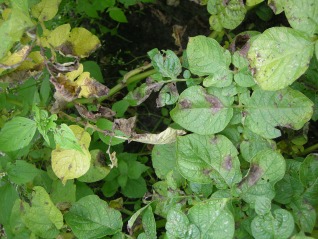Figure 1.

Potato plants with typical late blight lesions. Infection starts when a spore lands on the leaf and germinates. The germ tube forms an appressorium and an emerging penetration peg pushes into an epidermal cell. Then the inner cell layers are colonized. During the biotrophic phase, hyphae grow in the intercellular space, whereas haustoria enter plant cell cavities and invaginate host cell plasma membrane. Later, Phytophthora infestans switches to necrotrophic growth, resulting in the death of plant cells and the appearance of necrotic lesions on the infected tissues. In this phase, hyphae escape through the stomata and produce numerous asexual spores, named sporangia, that easily detach and disperse by wind or water. A sporangium that finds a new host can either germinate directly and initiate a new cycle or, at lower temperatures, undergo cleavage resulting in a zoosporangium from which six to eight flagellated spores are released. These zoospores can swim for several hours but, once they touch a solid surface, they encyst and germinate to initiate new infections. Under favourable conditions, the pathogen can complete the cycle from infection to sporulation in 4 days. In the field, this cycle is repeated multiple times during one growing season, resulting in billions of spores and a continuous increase in disease pressure. In addition to leaves, stems and tubers are also infected and P. infestans can continue to flourish on the decaying plant material. If not managed properly, infected seed potatoes or waste on refuse piles are often the sources of inoculum for new infections in the spring. An alternative route for surviving the winter is via oospores, sexual spores that can survive in the soil for many years. Phytophthora infestans is heterothallic; isolates are either A1 or A2 mating type, and sex organs only develop when isolates of opposite mating type sense the sex hormone produced by the mate.
